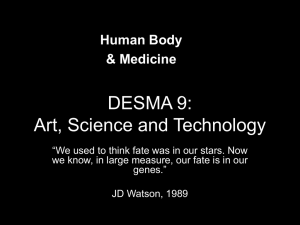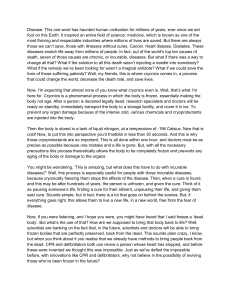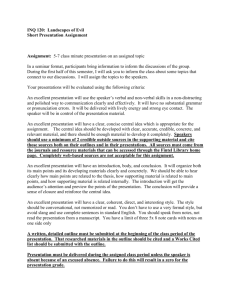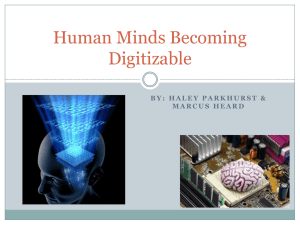COMM 220: Fundamentals of Public Speaking
advertisement
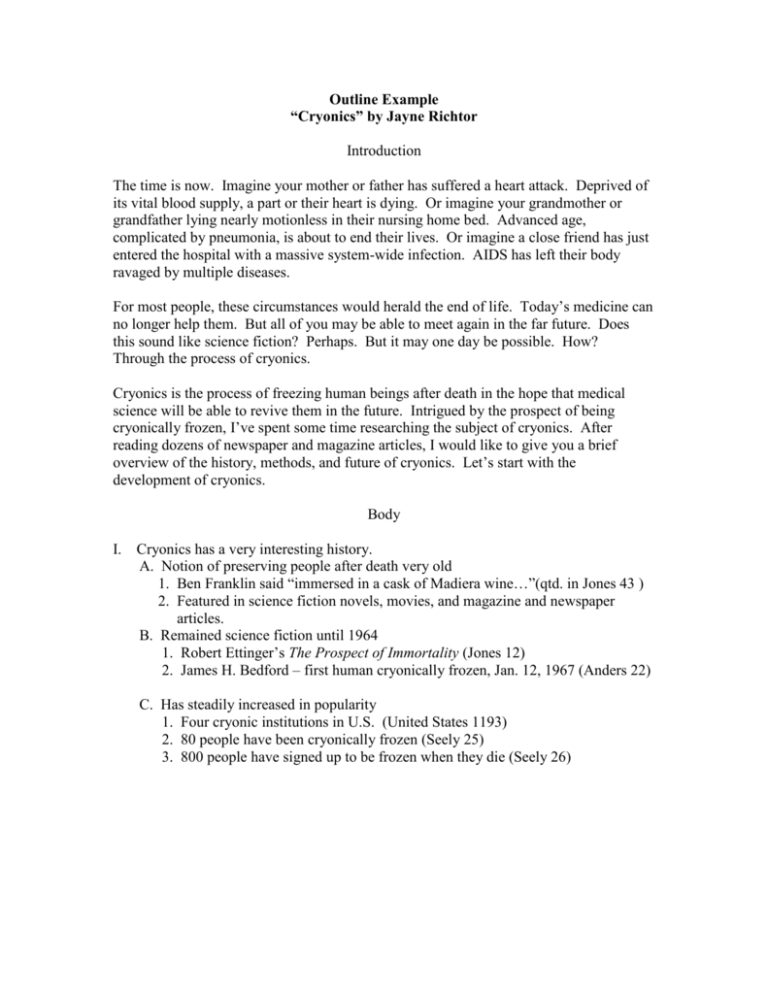
Outline Example “Cryonics” by Jayne Richtor Introduction The time is now. Imagine your mother or father has suffered a heart attack. Deprived of its vital blood supply, a part or their heart is dying. Or imagine your grandmother or grandfather lying nearly motionless in their nursing home bed. Advanced age, complicated by pneumonia, is about to end their lives. Or imagine a close friend has just entered the hospital with a massive system-wide infection. AIDS has left their body ravaged by multiple diseases. For most people, these circumstances would herald the end of life. Today’s medicine can no longer help them. But all of you may be able to meet again in the far future. Does this sound like science fiction? Perhaps. But it may one day be possible. How? Through the process of cryonics. Cryonics is the process of freezing human beings after death in the hope that medical science will be able to revive them in the future. Intrigued by the prospect of being cryonically frozen, I’ve spent some time researching the subject of cryonics. After reading dozens of newspaper and magazine articles, I would like to give you a brief overview of the history, methods, and future of cryonics. Let’s start with the development of cryonics. Body I. Cryonics has a very interesting history. A. Notion of preserving people after death very old 1. Ben Franklin said “immersed in a cask of Madiera wine…”(qtd. in Jones 43 ) 2. Featured in science fiction novels, movies, and magazine and newspaper articles. B. Remained science fiction until 1964 1. Robert Ettinger’s The Prospect of Immortality (Jones 12) 2. James H. Bedford – first human cryonically frozen, Jan. 12, 1967 (Anders 22) C. Has steadily increased in popularity 1. Four cryonic institutions in U.S. (United States 1193) 2. 80 people have been cryonically frozen (Seely 25) 3. 800 people have signed up to be frozen when they die (Seely 26) II. When a person who has signed up to be cryonically frozen dies, a specific procedure must be carried out. (Seely 54-60) A. Person must decide whether the whole body or the head should be frozen B. If the whole body, it must be preserved. 1. Immediately after death, connected to heat-lung machine 2. Chemicals circulated to prevent tissue damage 3. Cold packs used to reduce internal temperature C. If only the head is used 1. Head surgically detached and preserved in separate container 2. Why someone would choose to preserve only head a. body may be in very poor condition b. hope that science would be able to create new body in future D. Once head or body is ready, process proceeds 1. Cryoprotectorants circulated to reduce cell damage 2. Over 20 days, body or head cooled to negative 320 degrees a. Stored in steel cylinder of liquid nitrogen to maintain temperature b. Biological function stops and patient will not change for hundreds of years (“Deep Freeze” 67) III. Two major issues in the future of cryonics are its high cost and the need to perfect the freezing and rethawing process A. Cost from $60,000 - $125,000 (Anders 72) 1. Can be paid for by life insurance 2. Facing own mortality more difficult than getting the money B. Details of freezing and rethawing aren’t worked out 1. Freezing inflicts a large amount of cell damage (“Limits of Immortality” 33) a. Only a few types of human tissue can be frozen and thawed successfully b. Not possible now to freeze and rethaw complicated organs, much less bodies or brains 2. Scientists working on ways to reduce damage caused by freezing process (“Deep Freeze” 65) a. Researching better cryoprotectorants to control cell damage b. Developing microscopic machines to repair cells at molecular level Conclusion In closing, we have seen that cryonics is much more than a plot in a science fiction novel. It has developed from a wholly unrealistic fantasy to the point that 80 people have already been frozen and hundreds more have made the choice to be cryonically frozen when they die. If scientists can ever figure out how to rethaw people successfully, we can be sure that cryonics will become much more popular. So think again of your father or mother suffering a heart attack, your grandmother or grandfather dying of pneumonia, or your close friend stricken with AIDS. If they chose to be buried or cremated in traditional fashion, their physical minds and bodies would be destroyed. That is absolutely certain. By contrast, being cryonically frozen offers some small chance that they may be revived in the future. Even if that chance is small it’s more than no chance at all. In addition, you must submit a Works Cited page using MLA format.
